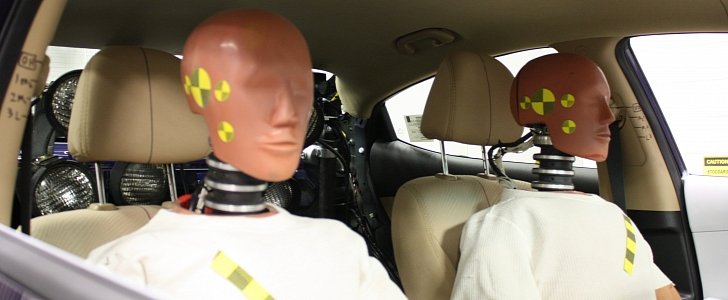Safety standards have increased dramatically in the last decade, but not all the occupants of a vehicle are as safe as those sitting in the front seats.
The popularity of ride-sharing apps like Uber and Lyft has made US regulators at NHTSA and IIHS ponder the safety of adult occupants in the rear seats of a vehicle.
Most of you might not know this, but standard crashworthiness testing done worldwide does not include placing a dummy simulating an adult passenger on the back seats of a car. Instead, models that mimic children are used, as if people would only drive with kids in the backseat.
As a Bloomberg report notes, the NHTSA will introduce crashworthiness testing of adult-sized dummies in the back seats of new-model vehicles starting in 2019.
For a model to achieve a five-star safety rating in 2019, it would have to get a good score for “rear adult occupant protection,” or whatever term the NHTSA will use for this.
The same report presents an interview with Kristy Arbogast, an engineering director of the Center for Injury Research and Prevention at Children’s Hospital of Philadelphia. The quoted person explains that five-star safety ratings on cars do not extend to all seating location, as “the back seat has not kept up.”
In other words, automakers were stimulated by regulators and crash testing procedures to enhance the safety level provided to front occupants, while the people sitting in the rear seats were “forgotten.”
Because of this, the standard of security created for the front occupants will not be matched by the one offered for passengers sitting in the rear seats. In some cars that suffer from rear-end collisions, the front seats have “a tendency to collapse over the rear occupants,” and the impact could be so severe that it could kill the rear occupants.
In the meantime, safety regulators and hospital representatives are drawing an alarm to those sitting in the back seats of a vehicle, especially taxis and commercial transporters. They enforce the recommendation of wearing a seat belt, as the un-belted passengers can suffer from concussions and fractures following a rear-end collision.
We would like to note that, in a passenger car, the rear occupant can also harm the person seated in front of them if they do not wear a seatbelt and the vehicle gets into a frontal collision. This fact alone should be an incentive to drivers that don't ask their passengers to wear seatbelts in the rear seats. So buckle up and stay safe!
Most of you might not know this, but standard crashworthiness testing done worldwide does not include placing a dummy simulating an adult passenger on the back seats of a car. Instead, models that mimic children are used, as if people would only drive with kids in the backseat.
As a Bloomberg report notes, the NHTSA will introduce crashworthiness testing of adult-sized dummies in the back seats of new-model vehicles starting in 2019.
For a model to achieve a five-star safety rating in 2019, it would have to get a good score for “rear adult occupant protection,” or whatever term the NHTSA will use for this.
The same report presents an interview with Kristy Arbogast, an engineering director of the Center for Injury Research and Prevention at Children’s Hospital of Philadelphia. The quoted person explains that five-star safety ratings on cars do not extend to all seating location, as “the back seat has not kept up.”
In other words, automakers were stimulated by regulators and crash testing procedures to enhance the safety level provided to front occupants, while the people sitting in the rear seats were “forgotten.”
Because of this, the standard of security created for the front occupants will not be matched by the one offered for passengers sitting in the rear seats. In some cars that suffer from rear-end collisions, the front seats have “a tendency to collapse over the rear occupants,” and the impact could be so severe that it could kill the rear occupants.
In the meantime, safety regulators and hospital representatives are drawing an alarm to those sitting in the back seats of a vehicle, especially taxis and commercial transporters. They enforce the recommendation of wearing a seat belt, as the un-belted passengers can suffer from concussions and fractures following a rear-end collision.
We would like to note that, in a passenger car, the rear occupant can also harm the person seated in front of them if they do not wear a seatbelt and the vehicle gets into a frontal collision. This fact alone should be an incentive to drivers that don't ask their passengers to wear seatbelts in the rear seats. So buckle up and stay safe!

